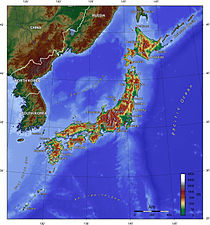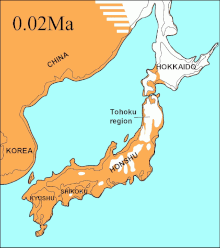| Revision as of 07:28, 24 June 2013 editTbhotch (talk | contribs)Autopatrolled, Extended confirmed users, Page movers, File movers, Pending changes reviewers, Rollbackers313,376 edits unexplained removal of content← Previous edit | Revision as of 07:52, 24 June 2013 edit undo75.70.142.23 (talk) what content requires a source? be specific, or else this is common sense knowledgeNext edit → | ||
| Line 1: | Line 1: | ||
| {{single source|date=June 2013}} | |||
| ] of ]]] | ] of ]]] | ||
| ] | ] | ||
Revision as of 07:52, 24 June 2013


The Japanese archipelago (日本列島, Nihon Rettō) are the islands that form the country of Japan, extends roughly from northeast to southwest along the northeastern coast of the Eurasia mainland, washing upon the northwestern shores of the Pacific Ocean. It comprises islands from the Sakhalin island arc and the Northeastern Japan arc. The main island is Honshu.
The term Home Islands was used at the end of World War II to define the area of Japan to which its sovereignty and the constitutional rule of the Emperor would be restricted. The term is also commonly used today to distinguish the archipelago from Japan's colonies and other territories in the first half of the 20th century, but is not used in reference to the country as it exists today.
Island components
The archipelago comprises 6,852 islands ("island" defined as land more than 100 m in circumference), of which 430 are inhabited. The four main islands, listed from north to south, are as followed:
Palaeogeography
Main articles: Sea of Japan § Geography and geology, and Japanese PaleolithicChanges to the Japanese archipelago over time:



| – regions above sea level | |
| (white color) – unvegetated land | |
| – sea |
References
See also
External links
This Japanese location article is a stub. You can help Misplaced Pages by expanding it. |